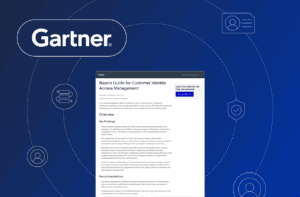Authentication? Authorization? It’s all just logging in, right? Not exactly. While both terms are well known yet often used interchangeably, they are separate processes that both play an integral part in a larger system known as identity and access management (IAM).
Knowing the difference between the two is imperative for implementing processes for your organization and customers. As data breaches continue to increase year after year, secure authentication and authorization are the first line of defense to prevent your customers’ information from landing in the wrong hands.
At a quick glance, the main difference between authentication and authorization is that authentication is the process of verifying who a customer is, whereas authorization is the process of enforcing what a customer can and cannot do.
In this article, we define both authentication and authorization and compare the key differences between them.
What is authentication?

Authentication is the process of verifying a customer is in fact who they say they are. This is typically the first step in any IAM process.
There are three factors of authentication, and you can mix factors for added trust. These factors are knowledge (something I know), possession (something I have), and inherency (something I am).
When more than one of these factors is in use, it’s called multi-factor authentication or MFA. Here are a few examples of each factor of authentication:
- Possession: a hard token, USB key or mobile device
- Knowledge: a password, PIN or answer to a challenge question
- Inherency: facial recognition, fingerprint or other biometrics
Most single-factor authentication requires a user to declare who they are (a username) and answer a knowledge-based challenge (a password). This low-security approach to authentication brings the burdens of security holes and a poor user experience.
A strong alternative is passwordless authentication which eliminates all password-derived vulnerabilities. These include all usernames and passwords, one-time passwords and email magic links. Passwordless authentication relies on the “something you are” factor making it harder for hackers to impersonate legitimate customers or steal their credentials.
What is authorization?
Authorization typically happens after a customer is properly authenticated. Now that the customer has been verified and confirmed as the intended user, authorization determines what that customer has access to.
Authorization works through pre-determined settings that are implemented and maintained by the organization. This will decide which customers have partial or full access to carry out certain functions such as transferring money or downloading a document. An example of a popular authorization technique is Role-Based Access Control (RBAC) where authorization is based on group-based privileges.
Comparing the differences between authentication vs. authorization
Authentication |
Authorization |
| Determines if a user is in fact who they say they are | Determines what customers can or can’t access |
| Asks a customer to validate their identity using a password or their biometric information such as fingerprint or facial scan | Verifies if a customer is allowed access based on pre-set rules and policies |
| Always comes first in the IAM process | Always follows after authentication |
| Authentication is an active action by the customer | Authorization is a calculation made by the application |
Implementing passwordless authentication with Transmit Security
Given the current state of authentication, the growing issue of password fatigue and the many other problems that passwords present, Transmit Security set out to create a passwordless authentication service that would provide organizations with a secure, cross-channel authentication customer experience.
BindID is the only natively passwordless service that provides a completely password-free customer login experience. The development of this technology represents a dramatic leap forward in the industry as BindID improves both security and customer experience.
Ready to learn more about passwordless authentication? Find out more about BindID today!



